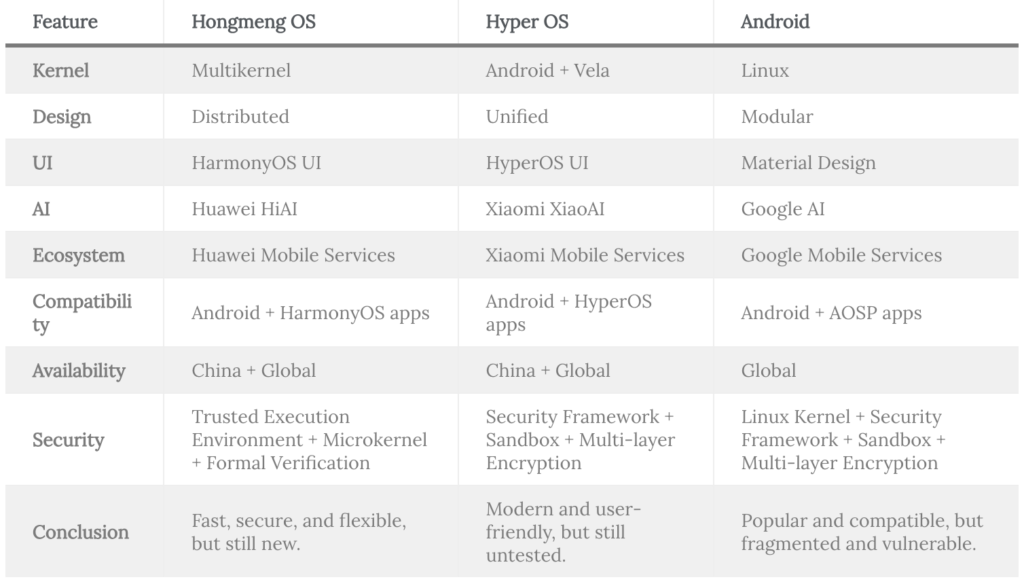Explore the differences between Hongmeng, Hyper OS, and Android in terms of history, features, pros and cons, security, compatibility, and future. Make an informed decision on the best operating system for your needs.
Operating systems play a crucial role in the functionality of devices like smartphones, tablets, smartwatches, and more. In this article, we delve into a detailed comparison of three popular operating systems: Hongmeng, Hyper OS, and Android. We’ll explore their origins, features, advantages, disadvantages, target audiences, and future prospects to help you choose the right one for your preferences.
Hongmeng OS
Overview
Hongmeng OS, also known as HarmonyOS, is Huawei’s distributed operating system designed for its devices and other smart devices. Launched in August 2019 in response to US sanctions on Huawei, it boasts unique features:
- Multikernel design with dual frameworks for adaptability.
- Cross-device communication and collaboration.
- Declarative development model for simplified coding.
- Modularized architecture for customization and optimization.
Pros and Cons
Pros:
- Fast, smooth, secure, and flexible.
- Seamless user experience across devices.
- Leverages Huawei’s ecosystem and innovation.
Cons:
- New and immature.
- Limited compatibility outside China.
- Faces challenges from US sanctions and competition.
Target Audience
Mainly for Huawei’s loyal customers, fans, and those valuing performance, security, and interconnectivity. Suitable for developers and enterprises in IoT and smart industries.
Security
Relies on Huawei’s Trusted Execution Environment (TEE) and microkernel design for isolation and formal verification for code correctness.
Compatibility
Multikernel and distributed design enable compatibility with various devices. Supports both Android and HarmonyOS applications.
Future
Huawei plans to expand coverage to over 300 million devices by 2023, making it open-source and globally adopted.
Hyper OS
Overview
Hyper OS, or SurgeOS, is Xiaomi’s new operating system connecting personal devices, cars, and smart home devices. Launched in October 2023 with the Xiaomi 14 flagship, it features:
- Based on Android with deep evolution and self-developed Vela system.
- Cross-device data synchronization and collaboration.
- New UI, design system, notification system, and AI engine for an enhanced user experience.
Pros and Cons
Pros:
- Modern, beautiful, and user-friendly.
- Smooth user experience across devices.
- Leverages Xiaomi’s ecosystem and innovation.
Cons:
- New and untested.
- Limited compatibility outside China.
- Faces challenges from Google’s Android services and competition.
Target Audience
Mainly for Xiaomi’s loyal customers, fans, and those valuing aesthetics, convenience, and intelligence. Suitable for developers and enterprises in the smart ecosystem and IoT.
Security
Relies on Xiaomi’s self-developed security framework, sandbox mechanism, and multi-layer encryption for data and privacy protection.
Compatibility
Flexible and modular design ensures compatibility with various devices. Supports both Android and Hyper OS applications.
Future
Xiaomi plans to expand coverage to over 200 products, from smartphones to electric cars, aiming for open-source and global adoption.
Android
Overview
Android, a mobile operating system based on a modified version of the Linux kernel, is designed for touchscreen devices. Developed by the Open Handset Alliance, mainly by Google, it features:
- Open-source and freeware nature for customization.
- Cross-device communication and collaboration with Google’s ecosystem.
- Rich application market with millions of apps.
Pros and Cons
Pros:
- Popular, widely used, and compatible.
- Offers a variety of choices and options.
- Leverages Google’s ecosystem and innovation.
Cons:
- Fragmented, inconsistent, and vulnerable.
- Issues with performance, stability, security, and updates.
- Faces restrictions and regulations.
Target Audience
Mainly for general users and developers valuing openness, diversity, and functionality. Suitable for enterprises in mobile and IoT markets.
Security
Relies on the Linux kernel, Android security framework, sandbox mechanism, and multi-layer encryption for protection.
Compatibility
Flexible and modular design ensures compatibility with various devices. Supports Android applications and other platforms.
Future
Uncertain, as Google plans to replace Android with a new operating system called Fuchsia, designed to be more scalable, secure, and adaptable.
Comparison of the three operating systems
The following table compares the three operating systems based on their key features

Conclusion
In conclusion, Hongmeng OS, Hyper OS, and Android each have their strengths and weaknesses. Your choice depends on your needs, preferences, and expectations. Explore each operating system to determine which one suits you best.





